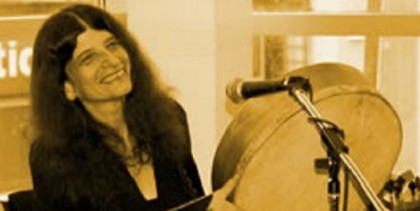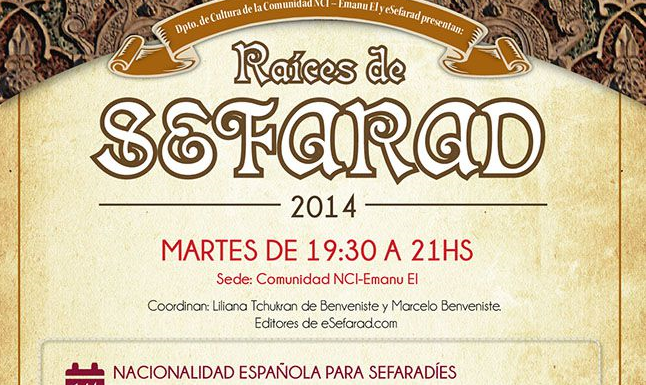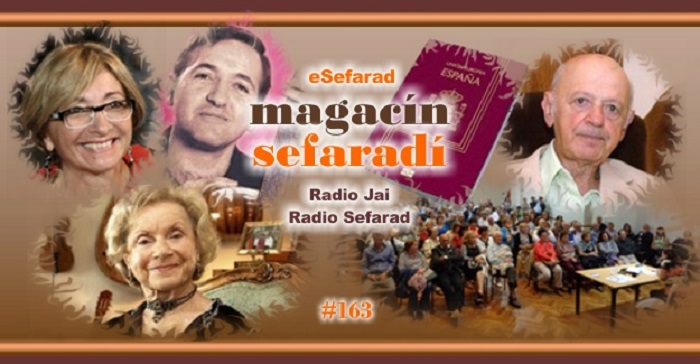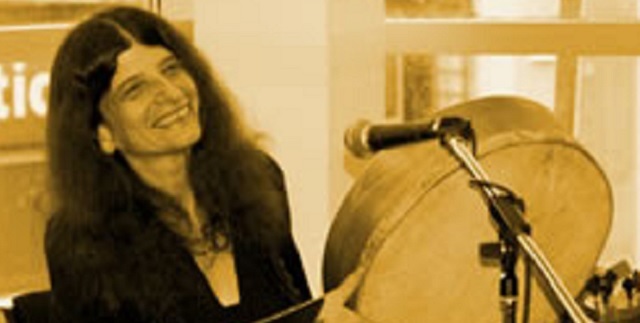EMPEZAR QUIERO CONTAR, CON JUDITH COHEN – En la entrega anterior os hablaba de las canciones de las circunstancias de la vida cotidiana. Los temas que escuchamos en aquel programa eran más bien divertidos, pero hoy nos queda un aspecto serio del cancionero sefardí. Se trata de las canciones que recuerdan o comentan las grandes tragedias, las canciones que expresan la tristeza, incluso la desesperanza, – pero, como el judaísmo valora siempre la vida, las hay también que cantan la esperanza. Empezamos con un acontecimiento del año 1917, el incendio de Salónica, que empezó en el barrio judío, en shabat, y destruyó una gran parte de la ciudad. Canta David Saltiel, de Salónica.
Los judíos de Marruecos, en general, convivían bastante bien con la mayoría musulmana del país, pero sin embargo surgían algunas situaciones complicadas. En el siglo XIX, una bella joven judía, Sol o Solika, con tan solo 17 años de edad, eligió y sufrió una muerte muy cruel porque no quería abandonar su religión. Después, no solamente los judíos de Marruecos sino también los musulmanes empezaron a visitar la tumba de la joven – “Solika la tsadiká”, en árabe “Lalla Suleika”. Canta Esther Roffe, de Alcazarquivir, Marruecos, que vive en Venezuela.
Esto fue en los años 1830. Y un siglo más tarde, el Holocausto. Las canciones en ídish de aquellos tiempos tan espantosos son bastante conocidas, pero la poesía de los sefardíes en el Holocausto sólo empezó a ser conocida hace relativamente poco tiempo y en gran parte gracias a dos obras importantes: primero el libro de Isaac Jack Levy, “And the World Stood Silent” y, más recientemente, “Un grito en el silencio” de Shmuel Rafael. En los años 80, en Montreal, Bouena Sarfaty Garfinkle, de Salónica, me contó sus experiencias en su ciudad durante la guerra. Ella había sido una joven partisana, y salvó la vida de numerosos bebés y niños judíos. Bouena me explicó que en el seder, la cena ritual de la Pascua judía, en Salónica cantaban una maldición del Faraón de Egipto y que, en su familia, en los años de la guerra, sustituían el nombre de éste por el de “Hitler”, así…
La música jugaba un papel complejo en la vida de los judíos de aquella época. Por un lado, cantar les ofrecía una especie de alivio, aunque muy reducido y muy breve, de los horrores de su vida cotidiana. Los nazis crearon orquestas en los campos de concentración para las actas oficiales y para ocultar los gritos de dolor. Al mismo tiempo, para los músicos elegidos para tocar en estas orquestas, era la única manera de salvar la vida; uno de ellos fue Jacques Stroumsa, sefardí de Salónica, conocido como “El violinista de Aushwitz”. Efectivamente, los nazis utilizaban la música como arma: otra manera más de torturar a los judíos. A los prisioneros les obligaban a cantar mientras hacían los trabajos más duros. Llegaban a exigirles canciones concretas que les obligaban a acordarse de los seres queridos. Sami Profetta de Salónica contó a la etnomusicóloga Gila Flam cómo les obligaban a cantar la canción italiana “Mamma so tanto felice”, “Mamá, me siento tan feliz”.
Agradezco al Museo del Holocausto en Washington DC por facilitarme esta grabación y también la que sigue. Avram Sadicario, médico y escritor sefardí de Macedonia, cantó el horroroso viaje a Auschwitz, grabado por SWS. Las letras fueron compuestas por David Haim.
Flory Jagoda, la “nona” de la música sefardí de su Bosnia natal, grabó su disco “Arvoliko” cuando ya tenía más de 80 años. Flory explica que el “arvoliko” de su canción – que dio título al disco – se refiere al árbol que fue, dice ella, “el mudo testigo… el único indicador de la fosa común de los 42 miembros de [su] familia, los Altaras, masacrados en la Segunda Guerra Mundial.
Medio siglo después, en los años 90, llegó otra tragedia a Bosnia, la guerra. En el mismo disco, Flory canta su versión musicada del poema de Isak Papo, “Saraj di Oro”, Sarayevo de Oro. También podemos decir, con el poeta “La cruela politika… la gente troca”: la cruel política cambia a la gente.
Pero el judaísmo siempre confirma la vida y la esperanza. Aquí Bouena Sarfatty Garfinkle me canta una canción optimista, de los años precedentes a la formación del Estado de Israel.
La canción habla del “lavoro” – y, sí, los pioneros, los jalutzim de Israel trabajaron muy duro para construir el país. Rachel Bereshit, de Esmirna, de Israel y de Montreal, me cantó esta canción de aquellos pioneros. El estribillo dice “Ayde, mani mani, dize cablan Yani…”. “Ayde”, en los países balcánicos, significa “animo!”; “mani mani” – en griego, “con prisa”; “caplan”, del “cablan” en hebreo, es contratista de construcción, y Yani es nombre griego.
Y la esperanza se encapsula el título del himno israelí, La esperanza, Hatikvá. Aquí lo canta el leyendario jazán y cantante turco Isaac Algazi en el año 1929, o quizás antes. Canta con una combinación más bien insólita de instrumentos: un piano con un laúd árabe.
Os voy a dejar con la voz de Berta/Bienvenida Aguado, cantando “Irme quiero a Yerushalayim”. Y tengo que deciros que no solamente se acaba el programa de hoy – sino que también se acaba esta serie de programas sobre la música sefardí. Quiero agradecer a todo el equipo de Radio Sefarad y especialmente a Jorge Rozemblum, que me invitó, y me animó, a preparar la serie. Gracias también a todos los que habéis escuchado, y a los que me habéis escrito. Pues, hasta la próxima, cuando sea – saludos desde Canadá, a todos los de Radio Sefarad, y a todos vosotros oyentes, de vuestra amiga Judith Cohen.
[TEXT IN ENGLISH:
- EMPEZAR QUIERO CONTAR, WITH JUDITH COHEN: Songs of despair and songs of hope
In the last programme, we listened to songs of daily life, often amusing. Today, in our last programme of this series, the time has come to consider songs which reflect tragedies, songs of deep sadness and utter despair – but, since Judaism always sees life itself as being of supreme importance, these are balanced by songs of hope. We’ll begin with a tragedy of the year 1917, the Great Fire of Salonica, which began in the old Jewish Quarter, one fateful shabbat, and destroyed a large part of the city. It’s sung here by David Saltiel, of Salonica itself.
Moroccan Jews, by and large, lived and still live (though in much reduced numbers) peacefully alongside the Muslim majority, but occasionally a difficult situation emerged. In the 19th century, during the 1830s, a beautiful young Jewish girl, just 17, Sol or Solika Hachuel, chose a cruel death rather than abandon her religion. I’m among the many people who have visited her tomb in the Jewish cemetary of Fès, the tomb of “Solika la tsadiká”, in Arabic “Lalla Suleika”. Here the ballad which narrates her story is sung by Esther Roffe, of Venezuela, whose family is from Alcazarquivir (Ksar-el-Kebir), Morocco.
A century later – the Holocaust. Yiddish songs from those dark times are well-known, Sephardic songs much less so, and only quite recently, first through the work of Isaac Jack Levy (“And the World Stood Silent”), and, more recently, Shmuel Refael’s “Un grito en el silencio” , “A Cry in the Silence.” In the 1980s, in Montreal, Bouena Sarfaty Garfinkle of Salonica told me about many of her experiences during the war. She was a young partisan, ggand saved the lives of many Jewish children. She told me that during the war years, in the seder, the ritual dinner of the first two nights of Passover, her family sang an old “curse of Pharaoh”, but changed it to a curse on Hitler, from “O, Faró, Faró” to “Ah, Hitler, Hitler.” Here she is singing part of it.
Music played a complex role in Jewish life of the time. On the one hand, singing offered them a kind of relief, though very limited and very short, from the horrors of daily life. But in the concentration camps, the Nazis had Jewish musicians form orchestras to play during official ceremonies, masking the cries of pain. For the Jewish musicians selected for this task, it was the only way to stay alive. One was Jacques Stroumsa, a Sephardic Jew of Salónica, known as “the violinist of Auschwitz”. Really, the Nazis used music as a weapon, one more way to torture their victims. They forced prisoners to sing as they performed the most difficult and exhausting tasks. They even sought out specific songs which forced them to remember their loved ones. Sami Profetta of Salónica told Israeli ethnomusicologist Gila Flam how they had forced him to sing the Italian song “Mamma so tanto felice”, “Mom, I’m so happy.”
I’d like to thank the National Holocaust Museum in Washington DC for sending me this recording and the next one. In it, Avram Sadicario, a doctor and writer of Macedonia, sings of the horrific train journey to Auschwitz. This was recorded by my friend and colleague Susana Weich-Shahak, and the words were composed by David Haim, to a Greek melody.
Flory Jagoda, the beloved “grandmother” or “nona” of Sephardic songs, especially those of her native Bosnia, recorded her CD “Arvoliko”, “Little Tree”, when she was over eighty years old. She explains that the “little tree” is the tree which, as she puts it, “ was the silent witness… the only sign of the mass grave of the 42 members of her Altaras family, massacred during the Holocaust. Half a century later, another tragedy hit Bosnia, the war of the 1990s. On this same CD, Flory sings her musical version of Isak Papo’s poem “Saraj di Oro”, Sarajevo the Golden. As the poet writes, we can also say “ “La cruela politika… la gente troca”:”cruel politics changes people”.
But, as I said, Judaism always opts for life and hope. Here Bouena Sarfatty sings an optimistic song, of the years just before the formation of the modern State of Israel. The song describes the “lavoro” – the hard work of the khalutzim , the pioneers, of Israel, building the country. Rachel Bereshit of Izmir, Israel and Montreal, sanf me this song of those early pioneers. The refrain says, “Ayde, mani mani, dize cablan Yani…”. “Ayde”, in Balkan countries, means, more or less, “let’s go!” “mani mani”, in Greek, “fast!”, and qablan, from Hebrew, is a construction contractor; Yani is a Greek name.
Hope is encapsulated in the Israeli national anthem, Hatikvá, literally, “the hope”. Here the legendary Turkish khazan Isaac Algazi sings it in 1929, possibly even earlier – in any case, long before Israel was formed as a modern state. It’s accompanied by the unlikely combination of piano and the Middle Eastern oud.
I leave you with the voice of Berta/Bienvenida Aguado, singing “Irme quiero, madre, a Yerushalayim”, “Mother, I want to go to Jerusalem.” And now the time has come to tell you that not only is today’s programme ending, but so is this series on Sephardic songs. I’d like to thank the Radio Sefarad team, and especially Jorge Rozemblum, who invited me, and kept encouraging me, to preapre these programmes. And of course, thanks to all you listeners, and those who have written to me. Till the next time, whenever it may be – greetings from Canada, to everyone at Radio Sefearad and all of you, from your friend, Judith Cohen.]




